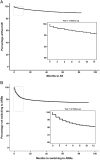Determinants of angiotensin-converting enzyme inhibitor (ACEI) intolerance and angioedema in the UK Clinical Practice Research Datalink
- PMID: 27524468
- PMCID: PMC5099558
- DOI: 10.1111/bcp.13090
Determinants of angiotensin-converting enzyme inhibitor (ACEI) intolerance and angioedema in the UK Clinical Practice Research Datalink
Abstract
Aim: The aim of the present study was to describe the occurrence and determinants of angiotensin-converting enzyme (ACE) inhibitor (ACEI) intolerance and angioedema (AE) among patients initiating ACEI therapy in a real-world primary care population.
Methods: Two nested case-control studies were conducted in a cohort of 276 977 patients aged ≥45 years initiating ACEIs from 2007 to 2014 in the UK Clinical Practice Research Datalink (CPRD). Cases of AE occurring for the first time during ACEI therapy (n = 416) were matched with AE-free controls (n = 4335) on the duration of ACEI treatment. Documented switches to angiotensin-II receptor blockers in the prescription records were used to identify ACEI-intolerance cases (n = 24 709), and these were matched with continuous ACEI users (n = 84 238) on the duration of ACEI therapy. Conditional logistic regression was used to assess the associations of demographic factors, comorbidities and comedication with AE and ACEI intolerance.
Results: AE during ACEI therapy was associated with age over 65 years [odds ratio (OR) 1.36, 95% confidence interval (CI) 1.07, 1.73], history of allergy (OR 1.53, 95% CI 1.19, 1.96), use of calcium channel blockers (OR 1.57, 95% CI 1.23; 2.01), use of antihistamines (OR 21.25, 95% CI 16.44, 27.46) and use of systemic corticosteroids (OR 4.52, 95% CI 3.26, 6.27). ACEI intolerance was significantly associated with more comorbidities and comedication compared with AE, including allergy (OR 2.02, 95% CI 1.96, 2.09), use of antiasthmatic drugs (OR 1.51, 95% CI 1.42, 1.61) and use of antihistamines (OR 1.53, 95% CI 1.43, 1.63).
Conclusions: Among ACEI users developing AE or ACEI intolerance, several comorbidities and comedication classes were significantly more prevalent compared with ACEI users not developing these adverse reactions.
Keywords: ACE inhibitor intolerance; ACE inhibitors; angioedema; angiotensin II receptor blockers; case-control studies; drug-related side effects and adverse reactions.
© 2016 The British Pharmacological Society.
Figures

Similar articles
-
Angioedemas associated with renin-angiotensin system blocking drugs: Comparative analysis of spontaneous adverse drug reaction reports.PLoS One. 2020 Mar 26;15(3):e0230632. doi: 10.1371/journal.pone.0230632. eCollection 2020. PLoS One. 2020. PMID: 32214375 Free PMC article.
-
ACE inhibitor-mediated angioedema.Int Immunopharmacol. 2020 Jan;78:106081. doi: 10.1016/j.intimp.2019.106081. Epub 2019 Dec 10. Int Immunopharmacol. 2020. PMID: 31835086 Review.
-
Angioedema Among Hypertensive Patients Treated with Aliskiren or Other Antihypertensive Medications in the United States.Am J Cardiovasc Drugs. 2017 Dec;17(6):465-474. doi: 10.1007/s40256-017-0242-3. Am J Cardiovasc Drugs. 2017. PMID: 28779444
-
Exome Sequencing Reveals Common and Rare Variants in F5 Associated With ACE Inhibitor and Angiotensin Receptor Blocker-Induced Angioedema.Clin Pharmacol Ther. 2020 Dec;108(6):1195-1202. doi: 10.1002/cpt.1927. Epub 2020 Jul 18. Clin Pharmacol Ther. 2020. PMID: 32496628 Free PMC article.
-
Angiotensin-converting enzyme inhibitor-induced angioedema: A review of the literature.J Clin Hypertens (Greenwich). 2017 Dec;19(12):1377-1382. doi: 10.1111/jch.13097. Epub 2017 Oct 10. J Clin Hypertens (Greenwich). 2017. PMID: 28994183 Free PMC article. Review.
Cited by
-
Angioedema associated with dipeptidyl peptidase-IV inhibitors.Clin Mol Allergy. 2021 Dec 6;19(1):24. doi: 10.1186/s12948-021-00164-7. Clin Mol Allergy. 2021. PMID: 34872575 Free PMC article. Review.
-
Five-Membered Nitrogen Heterocycles Angiotensin-Converting Enzyme (ACE) Inhibitors Induced Angioedema: An Underdiagnosed Condition.Pharmaceuticals (Basel). 2024 Mar 10;17(3):360. doi: 10.3390/ph17030360. Pharmaceuticals (Basel). 2024. PMID: 38543146 Free PMC article. Review.
-
The Rotterdam Study: 2018 update on objectives, design and main results.Eur J Epidemiol. 2017 Sep;32(9):807-850. doi: 10.1007/s10654-017-0321-4. Epub 2017 Oct 24. Eur J Epidemiol. 2017. PMID: 29064009 Free PMC article.
-
A Forgotten Cause of Allergy at ER That Is Still Difficult to Diagnose and Treat at Poor Resource Setting: Angioedema after Using Angiotensin Converting Enzyme Inhibitors for 4 Years.Case Reports Immunol. 2019 Jan 2;2019:1676391. doi: 10.1155/2019/1676391. eCollection 2019. Case Reports Immunol. 2019. PMID: 30723559 Free PMC article.
-
The Canadian Women's Heart Health Alliance Atlas on the Epidemiology, Diagnosis, and Management of Cardiovascular Disease in Women - Chapter 6: Sex- and Gender-Specific Diagnosis and Treatment.CJC Open. 2022 Apr 19;4(7):589-608. doi: 10.1016/j.cjco.2022.04.002. eCollection 2022 Jul. CJC Open. 2022. PMID: 35865023 Free PMC article. Review.
References
-
- Chan NJ, Soliman AM. Angiotensin converting enzyme inhibitor‐related angioedema: onset, presentation, and management. Ann Otol Rhinol Laryngol 2015; 124: 89–96. - PubMed
-
- Soo Hoo GW, Lin HK, Junaid I, Klaustermeyer WB. Angiotensin‐converting enzyme inhibitor angioedema requiring admission to an intensive care unit. Am J Med 2015; 128: 785–789. - PubMed
Publication types
MeSH terms
Substances
LinkOut - more resources
Full Text Sources
Other Literature Sources
Medical
Miscellaneous

